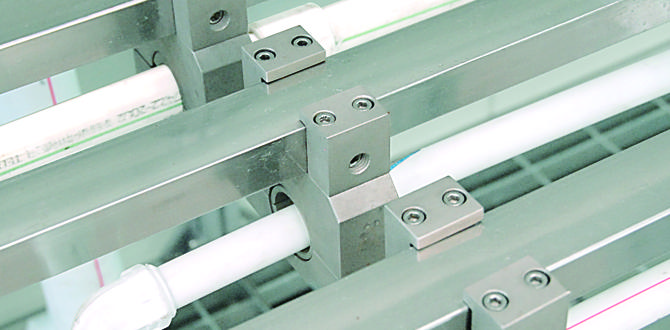Carbide end mills offer incredible “tool life” when used correctly. By understanding material properties, proper speeds and feeds, and maintenance, you can greatly extend their cutting lifespan, saving time and money in your workshop.
Carbide End Mill: Genius Tool Life for Machinists
Are you frustrated with end mills that seem to dull after just a few cuts? It’s a common headache for anyone working with metal or even some harder plastics. A dull end mill doesn’t just make for rougher cuts; it puts extra strain on your machine and can lead to broken tools. But what if I told you there’s a way to unlock amazing “tool life” from your carbide end mills, making them last significantly longer? We’re talking about turning a potential frustration into a dependable workhorse in your shop. Get ready to learn the secrets to making your cutting tools perform brilliantly, job after job. We’ll dive into what makes carbide special and how simple adjustments can make a world of difference.
What is a Carbide End Mill and Why Does Tool Life Matter?
An end mill is a type of milling cutter, essentially a rotating cutting tool with cutting edges along its sides and at the tip. It’s used to cut a broad range of operations, from slotting to profiling. When we talk about “tool life,” we’re referring to how long an end mill can perform its job effectively before it becomes too dull to cut properly or breaks entirely. This is crucial for a few big reasons:
- Cost Savings: End mills, especially carbide ones, aren’t cheap. The longer they last, the less you spend on replacements.
- Consistency: A sharp, well-maintained end mill delivers cleaner, more accurate cuts. A dull one can wander, creating scrap parts.
- Machine Health: Dull tools require more force to cut, which can put unnecessary stress on your milling machine’s spindle and bearings.
- Safety: Tools that snag or break unexpectedly can be dangerous, sending chips flying or even causing machine damage.
Carbide end mills are particularly popular because they are made from tungsten carbide, an extremely hard and wear-resistant material. This inherent hardness means they can often maintain their sharpness and cut at higher speeds compared to high-speed steel (HSS) tools. However, this hardness also makes them brittle. Understanding this balance is key to achieving “genius tool life”.
Understanding Carbide: The Material That Makes the Difference
Carbide, specifically tungsten carbide, is a composite material made by sintering (firing under pressure) cobalt powder with tungsten carbide particles. The result is an exceptionally hard and rigid material, second only to diamond in hardness. This makes it ideal for cutting tough materials like steel, stainless steel, and even hardened alloys.
Here’s why carbide is special for cutting tools:
- Hardness: It resists abrasion and wear, meaning it stays sharp for longer periods.
- Rigidity: It can withstand higher cutting forces without excessive deflection.
- Heat Resistance: Carbide can maintain its hardness at higher temperatures than HSS, allowing for faster cutting speeds (which generate more heat).
However, this incredible hardness comes with a downside: brittleness. Unlike HSS, which can bend, carbide is more prone to chipping or fracturing if subjected to shock, excessive vibration, or improper cutting parameters. This is where learning to optimize its use for “genius tool life” becomes essential.
Key Factors for “Genius Tool Life” with Carbide End Mills
Achieving exceptional tool life with your carbide end mills isn’t magic; it’s about understanding and controlling several key variables. Let’s break down the most important ones:
1. Material Being Cut
The hardness and machinability of the material you’re cutting have a massive impact on tool life. Softer materials like aluminum or mild steel will generally yield longer tool life than harder materials like stainless steel or tool steels. When dealing with tougher materials, you often need to reduce cutting speeds and feed rates, and sometimes use specialized coatings or geometries.
2. Understanding Speeds and Feeds
This is arguably the MOST critical factor for “genius tool life.”
- Spindle Speed (RPM): This is how fast the end mill rotates. Too fast, and you generate excessive heat, which can soften the cutting edge and lead to premature wear or even catastrophic failure. Too slow, and you might not be cutting effectively, leading to rubbing and increased vibration.
- Feed Rate (IPM or mm/min): This is how fast the tool moves through the material. Too fast, and you can overload the cutting edges, causing chipping or breakage. Too slow, and you may experience rubbing, poor chip formation, and increased heat.
The goal is to find a balance where the tool efficiently removes material without overheating or being overloaded. A good starting point for most carbide end mills involves using the manufacturer’s recommended speeds and feeds, which are often found on their packaging or website. Software like MachiningCalculator.com can also provide excellent starting points for various material and tool combinations.
The “Chip Load” Concept: A related concept is “chip load,” which is the thickness of the chip being removed by each cutting edge. For optimal tool life with carbide, you want to maintain a consistent, appropriate chip load. This is achieved by coordinating your spindle speed and feed rate correctly.
Calculating Speeds and Feeds (A Beginner’s Approach)
While advanced machinists might use complex formulas, beginners can start with these guidelines:
- Consult Manufacturer Data: Always look for recommendations from your end mill supplier.
- Use Online Calculators: Websites like those mentioned above are invaluable. You input your tool diameter, material, machine capability, and desired chip load, and it suggests RPM and feed rate.
- Start Conservative: When in doubt, start at the lower end of the recommended speed and feed range. Listen to the cut – it should sound like a consistent, clean slicing noise. If it sounds “chattery,” “squealy,” or like it’s rubbing, adjust.
- Make Small Adjustments: If the cut seems too aggressive, slightly reduce the feed rate or RPM. If it feels like it’s rubbing, slightly increase the feed rate or RPM (within reason).
3. Tool Geometry and Coatings
Not all end mills are created equal. Their design and any applied coatings play a huge role in their performance and life.
-
Number of Flutes:
- 2-flute end mills: Good for slotting and rapid material removal, especially in softer materials like aluminum. They provide more chip clearance.
- 3-flute end mills: A good general-purpose choice, offering a balance of cutting performance and rigidity.
- 4-flute end mills: Best for finishing, slotting in harder materials, and applications where rigidity is paramount. They provide less chip clearance but are more robust at the cutting edge.
- Helix Angle: A higher helix angle (e.g., 45 degrees) provides a slicing action that reduces cutting forces and vibration, often leading to a smoother finish and longer tool life, especially in softer materials. Low helix angles (e.g., 30 degrees) are more rigid and suitable for harder materials.
- Coatings: Many carbide end mills come with specialized coatings (like TiN, TiCN, AlTiN, ZrN). These coatings:
- Increase hardness.
- Reduce friction.
- Improve heat resistance.
- Act as a barrier between the tool and workpiece, extending tool life significantly, especially in demanding applications.
- “Reduced Neck” Feature: Tools like the “carbide end mill 1/8 inch 6mm shank reduced neck for g10 long tool life” often incorporate a reduced neck. This feature, where the shank diameter is smaller than the cutting diameter, can help avoid “remachining” the material in deep cuts or profiles, preventing chip recutting and thus extending tool life by preventing excessive heat buildup and wear.
4. Coolant and Lubrication
Proper cooling and lubrication are vital for managing heat, which is the enemy of carbide. Depending on your machine and the material:
- Flood Coolant: A continuous flow of coolant washes away chips and dissipates heat effectively.
- Mist Coolant: A fine spray of coolant and air offers good cooling with less mess than flood.
- Through-Spindle Coolant (TSC): Coolant delivered through the tool shank and out ports near the cutting edges is extremely effective for deep pockets and high-performance machining.
- Cutting Fluid/Paste: For manual machining or very simple setups, applying a specialized cutting fluid or paste with a brush can help reduce friction and heat.
Using the right coolant for the material being cut (e.g., a sulfur-free or synthetic coolant for aluminum) can make a significant difference in both cut quality and tool life.
5. Rigidity of the Setup
Vibration is a tool killer, especially for brittle carbide. A rigid setup means less chatter, fewer harmonic vibrations, and more consistent chip loads.
- Workholding: Ensure your workpiece is held securely and won’t move during the cut. Use appropriate clamps, vises, or fixtures.
- Tool Holder: Use a high-quality, clean tool holder. A runout of even a few “tenths” (thousandths of an inch) can drastically shorten tool life. ER collets, shrink-fit holders, or high-precision milling chucks are recommended.
- Machine Spindle: A worn spindle with excessive play will introduce vibration.
- Tool Length: Shorter tool engagements (i.e., not sticking too much of the end mill out of the holder) are generally more rigid.
For that specific “carbide end mill 1/8 inch 6mm shank reduced neck,” the reduced neck is also a feature that can help maintain rigidity in certain deep-pocketing scenarios by allowing for a shorter tool projection if needed, though it’s more about clearing obstacles and preventing recutting. Still, a well-balanced tool holder is paramount.
6. Chip Evacuation
Proper chip evacuation is crucial. Chips are hot; if they get recut, they transfer heat back to the tool and the workpiece, leading to tool wear and potential workpiece damage. This is where the “reduced neck” feature on a tool like the “carbide end mill 1/8 inch 6mm shank reduced neck” can be beneficial. By having a smaller diameter shank behind the cutting flutes, it allows for easier chip flow and evacuation, especially when cutting deep slots or complex 3D shapes.
Ensure your machine’s coolant flow is directed to effectively clear chips, or plan your toolpaths to minimize chip recutting.
7. Proper Machining Tactics
How you program your moves matters:
- Stepover and Steplift: When milling a larger area, the “stepover” is the distance you move sideways, and “steplift” is the depth of cut. Optimize these for your tool and machine for the best balance of speed and tool life.
- Ramping/Helical Interpolation: Instead of plunging straight down (which is hard on end mills), “ramp” into the material by feeding down at an angle. This distributes the cutting load over multiple flutes and the entire cutting edge, significantly extending tool life compared to plunging.
- Finishing Passes: Sometimes, it’s best to take a slightly heavier “roughing” pass with a more aggressive tool or parameters, followed by a light “finishing” pass with lower feed rates and shallower depth of cut to achieve the best surface finish and preserve the tool’s sharpest edges.
Maintaining and Inspecting Your Carbide End Mills
Even with careful use, periodic maintenance and inspection can help you get the most out of your carbide end mills.
Sharpening vs. Replacement
Unlike HSS tools, carbide end mills are very difficult to sharpen economically for most hobbyists and even many small shops. The specialized grinding equipment and expertise required often make it more cost-effective to replace a worn carbide end mill, especially for smaller sizes like the “carbide end mill 1/8 inch 6mm shank.” However, for larger, more expensive tools, professional resharpening services can be an option.
Inspection Checklist
Before and after each use, give your end mill a quick inspection:
- Look for Wear: Check the cutting edges for any signs of chipping, obvious dullness (a shiny land on the edge), or rounded corners.
- Check for Chips/Gouges: Look for any damage on the flutes or the cutting edges.
- Cleanliness: Ensure the tool is clean. Burrs or coolant residue can mislead you about its condition.
- Shank Condition: Ensure the shank is clean and undamaged, especially important for collet grip.
Storage
Proper storage prevents damage. Store your end mills in a dedicated case or tool holder to protect the cutting edges from accidental dings and chips.
Common Pitfalls to Avoid for “Genius Tool Life”
Even with the best intentions, certain mistakes can drastically reduce the life of your carbide end mills. Here are some to watch out for:
- Plunging Blindly: Driving an end mill straight down into the material without ramping is a common mistake that leads to rapid edge wear and breakage.
- Ignoring Vibration: If your machine is chattering or making unusual noises, stop immediately. It’s a sign of a problem that will likely break your tool.
- Recutting Chips: This happens in deep slots or pockets if chips can’t escape. It generates excessive heat and wears down the end mill quickly.
- Using Incorrect Speeds/Feeds: Guessing or using generic settings without referring to manufacturer data or calculators is a recipe for disaster with carbide.
- Worn Tool Holders: A tool holder that doesn’t grip the end mill tightly or has too much runout will cause vibration and uneven wear.
- Dry Machining Tough Materials: Trying to cut hardened steel or stainless steel without any coolant or lubrication is a fast track to burning up your end mill.
Case Study: The Little 1/8″ End Mill That Could
Let’s consider a specific example: that “carbide end mill 1/8 inch 6mm shank reduced neck for g10 long tool life” you might have. G10 (Garolite) is a very abrasive composite material. It loves to eat tools. Many beginners might try to cut it with standard end mills at high speeds, only to find the edges dull after just a few inches of travel.
To get “genius tool life” with such a tool in G10:
- Use a specialized end mill: One designed for composites, often with higher helix angles or specific flute geometries, and with a durable coating (like ZrN or TiB2). The reduced neck is helpful here for chip clearance.
- Slow Down Speeds, Increase Feed: You’ll likely need much slower spindle speeds (RPM) than you’d use for aluminum, but an appropriate feed rate to ensure each cutting edge is taking a clean bite (chip load).
- Prioritize Chip Evacuation: Ensure dust and chips are blown away effectively, possibly with compressed air or a vacuum integrated with your dust collection. A slightly higher feed rate can help ‘push’ chips out.
- Keep it Clean: G10 dust is abrasive. Regularly cleaning the tool and work area is paramount.
By following these principles, that tiny carbide end mill can perform exceptionally well and last far longer than you might expect, even in a challenging material like G10.
Table: Carbide End Mill vs. HSS End Mill for Tool Life
For a quick comparison, here’s how these materials stack up:
| Feature | Carbide End Mill | High-Speed Steel (HSS) End Mill |
|---|---|---|
| Hardness (as machined) | Very High | Moderate |
| Wear Resistance | Excellent | Good |
| Heat Resistance | Excellent (maintains hardness at higher temps) | Poor (loses hardness rapidly with heat) |
| Brittleness | High (prone to chipping) | Low (can bend) |
| Typical Speeds | Higher | Lower |
| Cost | Higher initial cost | Lower initial cost |
| Sharpening | Difficult/Expensive | Easier/More economical |
| Best For | Hard materials, high production, high-speed machining, demanding applications needing extended sharpness. | Softer materials, general-purpose machining, applications where tool breakage from vibration is a higher risk. |




